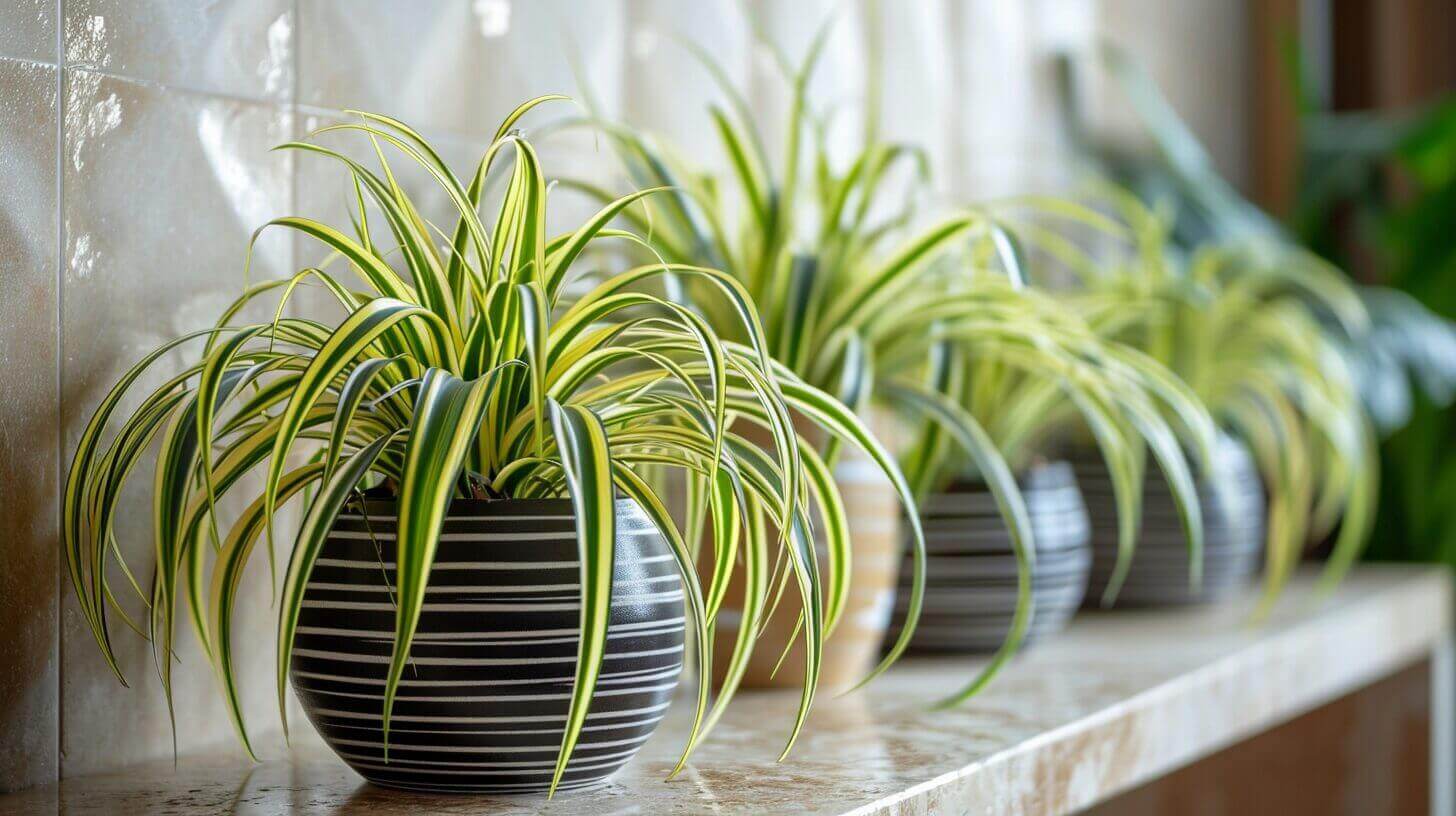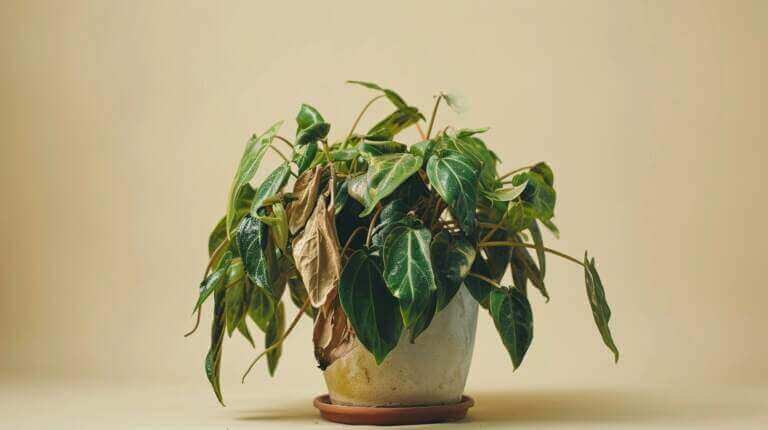Spider plants are not just beautiful additions to your home or office; they are also incredibly resilient and easy to care for. In this complete care guide for beginners, we will explore the essential steps to keep your spider plant thriving.
From finding the perfect spot to watering, feeding, and propagating, we will provide you with the knowledge and tools to ensure your spider plant flourishes.
Let’s dive into the world of spider plant care and create an environment that nurtures these fascinating plants.
Key Takeaways
- Spider plants prefer bright, indirect light and well-draining soil.
- They should be placed near a north or east-facing window for ideal sunlight.
- Proper hydration is important, so water once a week and mist to increase humidity.
- Spider plants require balanced, water-soluble fertilizer for proper nutrition, but over-fertilizing should be avoided.
Understanding Chlorophytum Comosum – Spider Plant Care
Undoubtedly, understanding the basics of caring for a spider plant is essential for successfully nurturing this resilient houseplant.
To begin, let’s explore the growth characteristics of spider plants. These plants, scientifically known as Chlorophytum comosum, are native to South Africa and are well-loved for their long, arching leaves that resemble spider legs. Spider plants are known to produce small offshoots or ‘babies’ that can be easily propagated to create new plants.
It’s important to note that spider plants prefer bright, indirect light and well-draining soil. Overwatering can lead to root rot, so it’s best to allow the top inch of soil to dry out between waterings.
When caring for spider plants, it’s crucial to be aware of common pests that may affect their health. The most common pests include spider mites, aphids, and mealybugs. Spider mites are tiny insects that suck the sap from the plant, causing yellowing leaves and web-like structures. Aphids are small, soft-bodied insects that feed on the plant’s sap, leading to distorted growth and sticky residue. Mealybugs are white, cottony pests that hide in the leaf axils and feed on the plant’s sap.
To combat these pests, regular inspection of the plant is necessary, along with insecticidal soap or neem oil treatments.
Finding the Perfect Spot for Your Spider Plant
When selecting a location for your spider plant, consider choosing a spot that offers bright, indirect sunlight and ample room for the plant to grow and cascade gracefully.
Spider plants thrive in bright, but not direct, sunlight, so it’s important to choose the right lighting conditions. Placing your spider plant near a north or east-facing window is ideal, as it will receive enough light without being exposed to intense sunlight that can scorch its leaves.
Avoid common mistakes such as placing your spider plant in a location with too much direct sunlight or in a dark corner where it won’t receive enough light. Insufficient light can cause your spider plant’s leaves to lose their vibrant green color and become pale or yellowish.
Additionally, make sure to provide ample space for your spider plant to grow and cascade. These plants have long, arching leaves that can spread out and drape beautifully. Give your spider plant enough room to showcase its graceful foliage and avoid crowding it with other plants.
Watering and Hydrating Your Spider Plant
Properly watering and hydrating your spider plant is essential for its overall health and growth. Spider plants are relatively low-maintenance, but they do have specific watering needs that should be met to ensure their well-being. Overwatering can lead to root rot, while underwatering can cause the leaves to turn brown and dry out. To help you understand the watering requirements of your spider plant, here is a helpful table:
| Watering Frequency | Signs of Underwatering | Signs of Overwatering |
|---|---|---|
| Once a week | Dry leaves and soil | Yellowing leaves and root rot |
In addition to regular watering, spider plants can also benefit from misting. Misting helps to increase humidity levels around the plant, which can prevent the tips of the leaves from turning brown and becoming dry. It is especially beneficial during dry winter months or in dry indoor environments. By providing adequate hydration through regular watering and misting, you can ensure that your spider plant thrives and remains healthy.
Feeding and Fertilizing Your Spider Plant
Feeding and fertilizing your spider plant is an important aspect of its care and maintenance. Just like any other living organism, spider plants require proper nutrition to thrive and stay healthy. When it comes to spider plant nutrition, choosing the right fertilizer is crucial.
Opt for a balanced, water-soluble fertilizer that is specifically formulated for houseplants. Look for a fertilizer with a ratio of 10-10-10 or 20-20-20, which represents the percentage of nitrogen, phosphorus, and potassium, respectively. This balanced formula will provide your spider plant with the necessary nutrients for growth and overall health.
It’s important to follow the instructions on the fertilizer package for proper application and dosage. Over-fertilizing can be harmful to your spider plant, so it’s best to err on the side of caution and use a diluted solution.
Propagating and Repotting Your Spider Plant
To successfully propagate and repot your spider plant, it is important to follow the correct techniques and guidelines.
Spider plant propagation is a simple process that involves taking stem cuttings and placing them in water or soil to develop roots. The best time to propagate spider plants is in the spring or summer when they are actively growing.
When repotting your spider plant, choose a pot that is slightly larger than the current one, ensuring it has drainage holes. Use a well-draining potting mix to provide adequate moisture and prevent root rot.
Gently remove the plant from its current pot, loosen the roots, and place it in the new pot. Finally, water the plant thoroughly and place it in a well-lit area to continue thriving.
Following these repotting techniques will help your spider plant grow and flourish.
Frequently Asked Questions
Can Spider Plants Be Grown Outdoors?
Spider plants can indeed be grown outdoors, as they are hardy and adaptable. However, they are more commonly kept as indoor plants due to their ability to thrive in a variety of lighting conditions and their air-purifying qualities.
Growing spider plants outdoors can offer benefits such as increased oxygen production and a natural aesthetic in the garden. However, it is important to provide the plants with adequate shade and protection from extreme weather conditions to ensure their health and longevity.
How Often Should I Clean the Leaves of My Spider Plant?
Regularly cleaning the leaves of a spider plant is essential for its overall health and appearance. By removing dust, dirt, and other contaminants, you can ensure optimal photosynthesis and prevent pests or diseases.
Cleaning frequency depends on the environment and the level of dust accumulation. Generally, wiping the leaves with a damp cloth every 2-4 weeks is recommended.
This practice not only promotes the plant’s well-being but also enhances the aesthetic appeal, making your spider plant a beautiful addition to any space.
Can Spider Plants Tolerate Direct Sunlight?
Spider plants are popular houseplants known for their ability to thrive in low light conditions. However, when it comes to direct sunlight, spider plants can tolerate it to some extent. While they prefer bright, indirect light, they can handle a few hours of direct sunlight each day.
It’s important to note that too much direct sunlight can cause their leaves to burn. To protect your spider plant from excessive sunlight, you can use a pebble tray to provide some shade and humidity.
What Are the Ideal Care Guidelines for a Spider Plant in Terms of Placement?
Yellowing spider plant leaves can be a cause for concern. There are several reasons why this may occur, including overwatering, underwatering, excessive sunlight exposure, or nutrient deficiencies. It is important to identify the underlying cause and take appropriate action to rectify the issue.
Regularly inspecting the plant, adjusting watering schedules, providing adequate sunlight, and fertilizing with a balanced plant food can help prevent and treat yellowing leaves. Consulting a plant care guide can provide detailed instructions for caring for spider plants.
Can Spider Plants Be Toxic to Pets?
Spider plants are a popular choice for indoor greenery, but pet owners often wonder if they are safe for their furry friends. When considering the safety of spider plants for pets, it is important to note that these plants are generally non-toxic to cats and dogs.
However, it is always wise to monitor your pets and discourage them from chewing on any plant.
If you are looking for alternative pet-friendly plants, options like Boston ferns, African violets, or Areca palms can be great choices.







